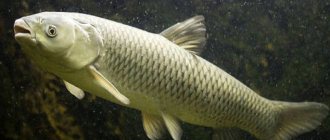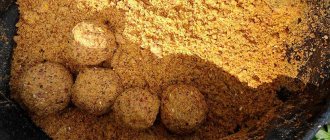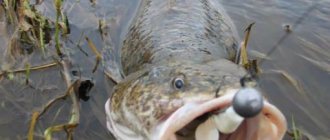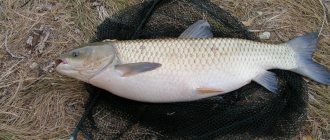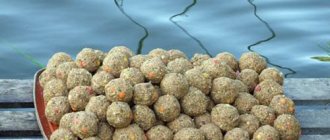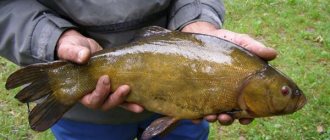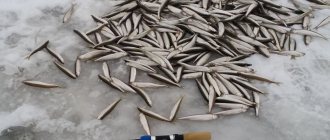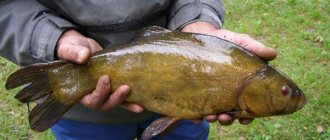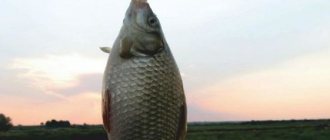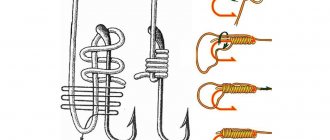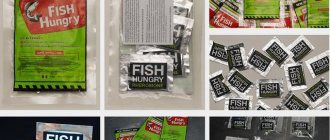Grass carp can grow up to 1.2 m , reaching a weight of about 30 kg .
This fish is widespread in East Asia and in the Amur River basin, from which it got its name. The basis of the diet of grass carp is the vegetation of reservoirs. The fry of this fish can feed on bloodworms or other invertebrates, but as they grow, they quickly switch to eating plant foods. Due to their herbivory, grass carp began to be released into reservoirs overgrown with algae to clean such reservoirs. The second name of this fish is grass carp. It not only cleans water bodies of unnecessary vegetation, but also has tasty meat. Moreover, grass carp grows quickly, which makes it possible for its industrial breeding. Based on this, grass carp is a valuable species of fish intended for industrial cultivation.
Features of catching grass carp
Initially, this fish was very difficult to catch because of its nutritional base, which consisted of aquatic vegetation, but over time, grass carp began to feed on other types of food offered to it and it began to be caught using baits traditional for anglers. Active biting of carp can be observed in the morning and evening hours, but sometimes, for some reasons, it becomes active in broad daylight. Grass carp are frightened by unnecessary noise on the shore, so you should prepare quite seriously for its capture. If there is food in the reservoir, this fish is unlikely to pay attention to anglers’ baits.
Some fishermen resort to some tricks to lure grass carp:
- Throw bait in the immediate vicinity of the thickets.
- They independently clean part of the reservoir, making original windows.
- Fishing is carried out at night, when there is a minimum of noise, near a reservoir.
- They bait grass carp for several days before fishing.
The best times for fishing for grass carp are considered to be warm, cloudless days without wind.
Fishing for carp in spring
In the second half of spring, productive carp fishing begins. When the grass turns green on the street and the first leaves appear on the trees, you can start catching it. The water at this time warms up to 15 degrees. In the southern regions this occurs in mid-April.
It’s better to wait for a really warm sunny day and go fishing for grass carp. The weather on the pond should be calm and windless. On the shore, extreme silence must be observed. If in the summer small noises are still allowed, then in the spring the cupid at the slightest rustle goes into the reeds and it is very difficult to lure him out of there. For this reason, in the spring it is caught mainly with float rods. When casting, they do not create such noise as donks or feeders.
The best bait in April will be pieces of cucumber, young shoots of reeds, and dough seasoned with dips. The earthworm also performed well. It takes specimens of medium and small sizes.
Features of catching grass carp in March, April and May
The bait is thrown a little further from the expected location of the carp. The nozzle is pulled slowly to the bait table. This creates the illusion of a natural fall or movement of food. At this time, the fish reacts to the bait and suddenly swims up to the hook and swallows it. The fisherman must have time to make a sweeping hook.
A few words about bait. It is needed less than in summer. How much less is estimated for a specific body of water. If you fish on a paid site, then the owners of the reservoir will provide you with this information.
The aroma in bait should be of medium strength. As the water warms up, stronger odors are used. In warm and slightly heated water, natural smells work better: cucumber and herbal.
When fishing for carp in the spring, use the same equipment as in the summer. Only leashes are better made of fluorocarbon. They are practically invisible to fish. In spring, cupid is very careful, so you should not load the equipment with unnecessary elements: swivels and carabiners. The more inconspicuous the gear, the better. The summer fishing season for grass carp opens in mid-May. During this period, you can use donks, feeders and hooks. The aroma becomes richer and smells good. More and more food is required, as heat exchange processes in grass carp are more active.
In the article fishing in spring
you can learn how to catch other fish at this time of year.
Selection of tackle and accessories
For catching such powerful fish, ordinary and familiar gear is not suitable, since they cannot withstand the resistance of grass carp.
The main gear for catching grass carp are:
Plug
This is a long rod, reaching a length of about 13 meters, capable of withstanding the force of fishing for large specimens. The most important advantage of such a fishing rod is its durability. The gear used imitates a free-falling bait in the water column, which works very well to attract grass carp. The basis of a plug fishing rod is: rubber, length from 1.4 to 2.1 m, fishing line, diameter from 0.14 to 0.22 mm and a hook No. 10 attached to the fishing line.
Match fishing rod
A fishing rod of at least 4 m in length is selected. It is also possible to use shorter forms: it all depends on the fishing conditions, the main thing is that it is durable. As a rule, for catching grass carp, standard carp rods are selected, equipped with powerful reels for catching large specimens. The fishing line is selected with a thickness of about 0.4 mm, and a rigid cord is used as a leash.
Feeder
Feeder gear is used for catching grass carp in the spring, when there is still no green vegetation at the bottom of the reservoir. The length of the feeder can be within 4 meters and it is equipped with a reel of size 3500. A monofilament line with a diameter of 0.3 mm is installed on the feeder, as well as braided leashes, the length of which is selected experimentally. When catching this fish, it is very important that the bait is raised above the bottom level to 20 cm.
Fishing. Catching tackle for white carp.
Best bait
Initially, grass carp were caught on:
- cabbage leaf;
- green cucumber slices;
- dandelion leaves and stems;
- green pea or bean pods;
- various algae.
Such baits are still promising in our time, but the fish have become accustomed to new bodies of water and are not against trying baits such as:
- worm;
- bloodworm;
- crawling out;
- maggot.
At the same time, grass carp does not refuse peas, corn, wheat, etc. Given its varied preferences for different types of food, it is sometimes very difficult to choose an effective bait or bait. Therefore, when going fishing, it is better to take several types of baits with you and calculate the preference of grass carp, one by one sending them into the pond.
Some fishermen use tiger nuts to catch grass carp. This bait has a peculiar aroma that quickly spreads in the water and lures fish.
To prepare nuts, you need:
- Boil them in water for 1 hour.
- After finishing cooking. The nuts are infused in a bowl, wrapped in cloth.
- After cooling, an attractant is added to the mass to enhance the aroma.
- Ready-to-eat nuts are dried in the sun.
Baits of animal origin work well in stocked reservoirs, but traditional baits of plant origin are better used in reservoirs where there is little fish.
How to prepare a catchable bait for catching carp and grass carp?
Autumn fishing on the Amur.
Autumn fishing on the Amur.
A river called the Amur, which ranks fourth in the Russian Federation among large rivers, overflowed along the city of Khabarovsk and its edge all the way to China. More than one hundred and thirty species of fish live here, which is why fishing in these parts is a very popular activity. On the Amur and its tributaries you can catch many different types of fish, including: representatives of the salmon, whitefish, carp, sturgeon, catfish and many other species of fish. The Amur is perhaps the only river in Russia where such a diversity of ichthyofauna is found.
There are many ways of fishing, one of the most popular is spinning. Here you can catch predatory fish such as pike and perch using spinning rods. In the mountain channels of the Amur you can catch local timel and lenok on a hook. The most desirable fish for most spinning anglers is timel, because the weight of such a fish can exceed fifty kilograms. Of course, such fish require appropriate gear.
In the fall, fishermen also grab spinning rods in the hope of storing fish for the winter. At this time of year, fishing is good for pink salmon and salmon. And the best bait for this is the fly. At this time, you can note the frequent movement of fish, so the best option is to go fishing on a motor boat to quickly find a catchable place for such fast-moving fish. First of all, you need to check the main channels, where the fish travel from the riverbed to their habitat.
In autumn, fish can be caught on the Amur almost around the clock. It’s good to lure during the day; local pike and catfish go well with all kinds of lures. At night, artificial baits are useful; taimen respond well to them. In late autumn, you can try your luck in hunting for burbot or whitefish, since in the summer the probability of catching these representatives is extremely low.
Autumn is also the most favorable time for pike fishing. Fishermen confirm this with excellent catches. The largest concentration of pike occurs in areas of underwater elevations or a cape extending into the depths. It’s worth starting autumn fishing from such places. As for the choice of bait, do not forget that pike at this time of year becomes slow and chooses larger objects for hunting. Therefore, you should choose large and bright baits. At the end of September, the time comes for chebak lovers on the Amur River. Of course, its dimensions are not large, only (10-22 cm), but there are also larger specimens - 30-35 cm each. Catching a chebak is very simple, it bites on almost everything (dough, bread, bloodworm larva, earthworm), and its use bait will increase the effectiveness of your fishing. And of course, the most striking representative of the rivers of the Khabarovsk Territory is grass carp. In autumn, carp bite consistently only in warm, cloudy weather. Remember, carp is a heat-loving fish and on cold days there is very little chance of catching even the smallest of its representatives. But this is, of course, an exciting business, and a true fisherman sometimes faces the question of going fishing or buying trips to the UAE.
Share with friends:
Date of publication: 02/11/2014
Add a comment Cancel reply
Feeding technique
Grass carp loves corn most of all, so it should be present in all types of bait.
To prepare bait mixtures, the same ingredients are used as for most carp:
- peas;
- Hercules;
- corn grains;
- sunflower cake.
For the most part, grass carp are attracted to the strong aroma of corn, which even the most cautious fish cannot resist. Grass carp eats a lot, so a sufficient amount of bait is required. As a rule, when catching this fish, they do not skimp on bait and pour up to 2 kg of corn into one place. You should not immediately feed the place, but try to catch the fish without bait first and only after a negative result, feed the place.
If you want to catch a large fish, then it is better to cast the tackle a little further than the feeding area, where larger specimens are circling. As a rule, the bite is always better at the fishing point, but smaller individuals are eaten.
Habitats and catches
Starting from a depth of 1 m and ending with depths of 4 m, you can hope for a successful bite of grass carp. Based on the fact that it is bred artificially, it can be found in irrigation canals, reservoirs near thermal power plants, as well as in ponds that require constant cleaning of aquatic vegetation. It can also be found in heavily overgrown lakes and ponds, where there is enough food for it. This fish feels safe near fallen trees, snags and other objects in the water.
Seasonal bite of grass carp
From late spring to mid-autumn you can safely hunt for this fish.
in spring
During this period, grass carp are caught at moments of slow growth of aquatic vegetation, at water temperatures from +12 to +16C.
In summer
With the onset of real warmth, the bite of grass carp becomes more active, but it is not so easy to catch it, since there is enough natural food in the reservoirs. In the summer, it is very difficult to choose the right bait so that grass carp starts actively biting.
in autumn
This is the best period for hunting grass carp, as the fish senses the coming of winter and begins to stock up on nutrients. During this period, he bites on almost all baits offered to him. It is caught until the water cools down to +10C. In the autumn, the growth of aquatic vegetation stops and there is not enough natural food for it.
in winter
In winter, grass carp stops feeding altogether, staying in deep holes.
Catching grass carp. Action fishing.
Pike fishing on Amur fishing
A separate topic of Amur fishing is pike. Moreover, there have been plenty of toothy ones in recent seasons. Already last winter, anglers felt an increase in the pike family. On good days, during the daylight hours, up to a hundred tails were obtained from one single hole.
In summer the situation turned out to be no worse. Everyone who wanted to catch pike caught pike. With the onset of autumn, stories about successful pike fishing on the Amur have become more frequent. But this is not even the peak of her activity. Now, just before the freeze-up, she really becomes greedy for any bait. This fall we caught the toothy beauty more than once.
As usual, pike is greedy and insatiable. But, despite her natural greed, she is sometimes, oh, how capricious and impossible to understand. If you can somehow interpret the behavior of other fish, or convince yourself that you understand them, then never a pike. And even though the most ichthyological ichthyologists build super diagrams of its behavior with a lot of examples, there will still be no logic in it. For example, would you eat dinner on a full stomach? Clearly not. And pike, yes! And contrary to all logic. How interesting is fishing on the Amur in the fall.
